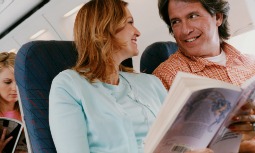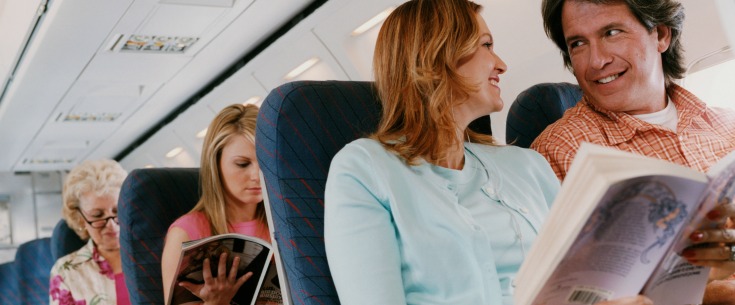It’s becoming a thing. Airline passengers who are so bothered by an obnoxious seatmate are taking to social media to share their mile-high sob story – and even share pics of the offenders.
Travel etiquette shouldn’t come to this: contentious face-offs and public shaming because someone wanted an extra armrest or wouldn’t put their shoes back on. Fortunately, there are a number of tactics at airline passengers’ disposal for tactfully and respectfully disarming angry, arrogant, intoxicated or simply clueless air passengers.
While some of the situations described in this article are divisive issues that we’ll never all agree on, we can all agree that there has to be a better way to resolving mid-air feuds than getting the TSA involved or ending up on a no-fly list for one reason or another. Practicing positive travel etiquette isn’t just about being nice to your fellow human beings because you want to be – it’s also about making sure we get where we need to safely and soundly – and with our shoes on.
When To Just Deal With It
Let’s start with kids. Maybe a tike is kicking your seat or making enough noise to disrupt your Microsoft Excel macro work. Just deal with it. Sure, that comes with endless caveats; is the parent overwhelmed or completely oblivious? Is it a 45-minute flight or a six-hour trek? Many industry experts suggest consulting with the flight attendant before confronting a parent. And if you feel justified and compelled to speak to a parent about their kids’ disruptive behavior, stick to the facts and don’t try to do any freelance parenting yourself. Try using some empathy – even if you have to fake it.1
The next situation where the best you can do is usually shrug your cramped shoulders has to do with sitting next to a tall or simply larger passenger. A 17.2-inch-wide seat is a tough fit for a 6’5” person. If the seatmate is doing everything he or she can to avoid entering your personal space, just let it go. Sacrifice the armrest and trade the laptop for the tablet. If there are empty seats on the plane, simply ask a flight attendant if you can change seats – that is, if they haven’t already suggested it. There may even be an opportunity to upgrade seats depending on the remaining inventory. By being patient and respectful, you’ll find that practicing sound travel etiquette can really pay off.
The Gray Areas
In a three-seat row with four armrests, who gets which armrest?
If you’re sitting in the window seat – and the occupants of the middle and aisle seat are sleeping – how do you signal that you need to use the bathroom?
And is everyone entitled to recline their seats whenever the little light above your seat says it’s OK?
The Wall Street Journal performed a fascinating study on these questions and others, asking everyone from veteran flight attendants to airline executives and frequent travelers their opinions.
These scenarios don’t necessarily have cut-and-dry travel etiquette you can apply universally. They’re not about obnoxious passengers as much as they’re about managing each scenario on a case by case basis, whether you’re the passenger potentially pushing buttons or the one absorbing a possibly perceived slight.
Some food for thought on each scenario: would you rather be woken up by your seatmate straddling you en route to the lav, or would you appreciate a gentle tap on the shoulder? Doesn’t the middle seat occupant have to deal with enough discomfort that he or she should get two armrests, while everyone else gets one? And doesn’t it just make sense to peek at the person sitting behind you to make sure they’re not eating, drinking or typing before gently reclining your seat?3
We certainly think so.
When To Speak Up
There are very few of us who want to bother with an awkward confrontation 30,000 feet up in the air. But some behavior cannot be ignored. For example, if you see someone breaking the rules or the FAA law – which could include anything from defying certain electronic device prohibitions to bringing cigarettes and Duct tape to the bathroom – you need to say something to a crew member. You owe it to all the passengers to so that you can arrive at your final destination without incident.
But what about the loud snorer? Flight attendants are adept at waking and diffusing these unsound sleepers. Or the obnoxious seatmate who appears to be intoxicated? Again, this is often a situation where stepping out of your row and discretely talking to a flight attendant is more effective than staging your own intervention.
If someone is in your personal space and doesn’t have a good reason to be, politely talking to the passenger is the most direct method of resolution, but not always the easiest. Try dropping something by them – and reclaiming your space as they pick it up. Or excuse yourself to use the restroom and using your re-entry to the row as an opportunity to stretch a bit and take the space that is rightfully yours.
If none of this works, you have two options. First, you could ask to sit in an empty seat or request a seat swap. And second, you could take to social media, a route more and more irate passengers are using to blow off steam and publically shame who they consider to be obnoxious seatmates.
Is Sharing Caring?
Take the case of Ryan Case, an editor for hit sitcom “Modern Family,” who used Twitter to complain about a loud and eventually unruly seatmate in September of 2014. The hilarious, 64-tweet rampage went viral, spreading well beyond her followers and becoming a mainstream news story. The seatmate was met by police upon landing.4
But you don’t need to be a borderline celebrity to find an audience to expose your obnoxious seatmate. Passenger Shaming is an increasingly popular Instagram and Facebook account where air travelers share pics of their nightmare travel companions. The pictures include everything from parents who let their newborns sleep in the aisle to a first class passenger who clipped his nails into a coffee cup, and tons of barefoot passengers who seemed to have forgotten that an airplane floor isn’t much cleaner than a public street.
Not only do airline travelers need to consider that they could be snapped and shared on these sites or others for behaving in an obnoxious way, but those using social media to report and share these scenarios should think carefully before pulling the trigger. These are moments, Tweets and pictures that will always be connected with you, too.
Just remember: one person’s “obnoxious” is another person’s “friendly.” Practice self-awareness and respectful travel etiquette before, after and during your flights. But also try to give your fellow travelers the benefit of the doubt whenever possible. After all, we’re all in this together. And by “this,” we mean flying tin can.
Related Articles








Share this Page